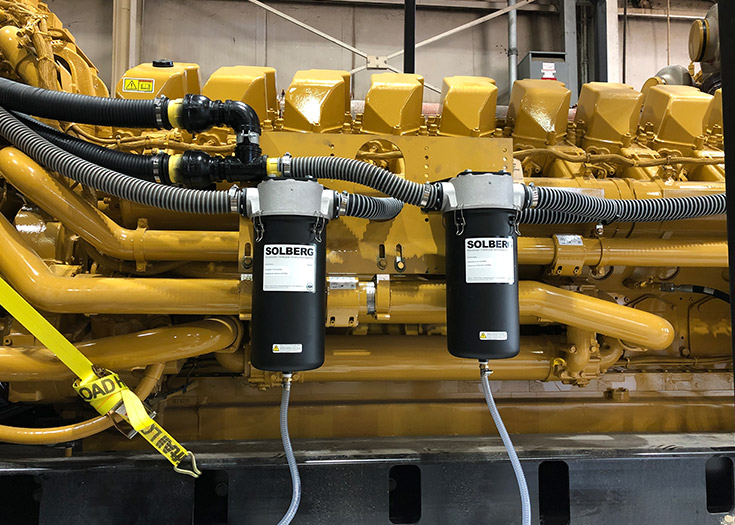
Crankcase ventilation systems capture hazardous blow-by emissions (oil mist and particulate) vented from the crankcases of both marine and stationary reciprocating engines and gen-sets. These crankcase ventilation systems promote environmental compliance and stewardship by safeguarding the operators in addition to the surrounding air, waterways, and land. The high efficiency filtration in crankcase ventilation systems protect an engine’s turbocharger, inter-cooler and exhaust catalyst from contamination. The results are optimized engine performance and a reduction in costly repairs for operators. Both open and closed style ventilation systems will regulate crankcase vacuum/pressure via manual or automatic controls to prevent leaks and oil loss through the engine seals.
A variety of applications and markets find huge environmental, financial, and operational benefit in deploying crankcase ventilation systems, including stationary power generation (continuous and stand-by duty) for both natural gas and diesel engines, mechanical drive, marine propulsion, CHP (combined heat and power) and biogas to energy.
For any engine, the most critical design criteria are the following:
- Vented worn engine blow-by flow
- Required crankcase vacuum or pressure
- Available suction from the turbocharger, and the differential pressure across the engine air cleaner.
However, each application presents its own unique challenges. This article discusses crankcase ventilation solutions as they relate and service unique challenges across various applications and industries.
Globally, environmental standards for reciprocating engines and gen-sets continue to become increasingly strict in regions around the world. In the U.S. the TIER rating system and RICE NESHAP emissions standard (Reciprocating Internal Combustion Engine National Emissions Standards for Hazardous Air Pollutants) are two prime examples of legislation to reduce the environmental impact from both natural gas and diesel-powered engines. In Europe, STAGE V is the primary stationary engine standard governing emissions from gen-sets and mechanical drive engines. The total engine emissions must not exceed certain levels to attain certification, and crankcase blow-by emissions can represent a significant percentage of the total (~25%). Without an effective crankcase ventilation system to capture the pollution engines will not achieve the latest standards, which then impacts commercial viability.
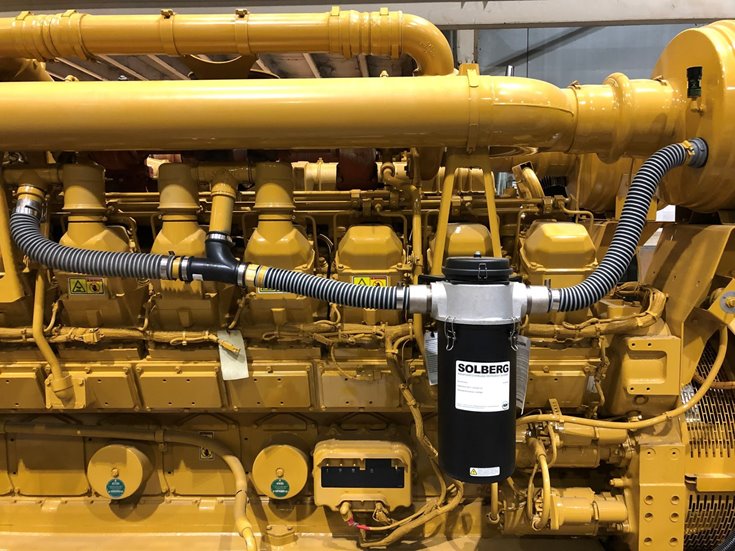
Closed crankcase ventilation system mounted on a diesel gen-set in a data center to prevent oily emissions from contaminating a surrounding high tech environment.
In addition to legislation, the Health, Safety and Environmental policies of power plants/energy producers is driving the demand for crankcase ventilation system retrofits and upgrades. With a large installed base of diesel and natural gas gen-sets, there are many plants struggling with vented oily crankcase emissions. The trend for operators is to reduce these emissions to protect their plant personnel, the surrounding environment and their equipment.
A high efficiency crankcase ventilation system is the best way to protect an engine’s intake system, turbocharger and exhaust catalyst while preventing hazardous atmospheric emissions. Large global brands such as Caterpillar, Cummins, Hyundai, Jenbacher, Kawasaki, Mitsubishi, Wartsila, Waukesha, etc are used in both continuous duty and stand-by operations. For continuous duty gen-sets and mechanical drive engines, vacuum assisted open crankcase ventilation systems are typically used to capture the oily emissions and vent the clean air into the atmosphere. Since the dirty emissions are not typically routed back through the engine intake, the results are optimized engine performance and a reduction in costly repairs due to cleaner combustion. However, with an open vent to atmosphere, it is important that operators capture the oil mist and particle emissions to protect the surrounding environment and plant personnel.
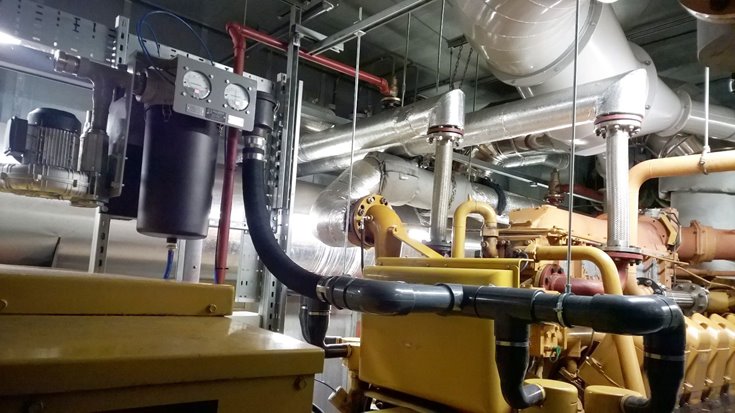
Vacuum assisted open crankcase ventilation system installed on a continuous duty natural gas gen-set at a university power station.
To be effective, vacuum assisted ventilation systems need to be sized for the worn blow-by flow of the engine. A complete system combines a high-efficiency filter, integrated vacuum source with electric motor, and associated piping and valves to regulate the vacuum or pressure in the crankcase. The operating crankcase vacuum/pressure level is dictated by the engine brand and model. For examples, see Solberg’s SME or BAE models which are engineered to meet specific requirements.
For stand-by diesel power applications such as datacenters, hospitals and universities, closed crankcase ventilation systems are most common. These engines rely on the suction/vacuum from the turbocharger/engine intake to draw emissions from the crankcase and through the high efficiency filter. Although operating hours for these gen-sets are limited, emissions efficiency is critical to avoid downstream contamination of the turbocharger and engine intake system. Any untreated crankcase emissions will migrate through the engine and negatively impact the total exhaust emissions of the engine. Also, given the sensitive and clean installation environments, emissions control is critical.
A Crankcase Ventilation System, such as the Solberg ACV Series, is a closed crankcase ventilation design that is sized based on the worn blow-by flow of the engine. This style uses vacuum/suction from the engine intake and turbocharger to draw the oil mist emissions through the high efficiency oil coalescing filter. An integrated diaphragm style valve controls the vacuum level on the crankcase side of the filter to meet the engine manufacturer’s requirements.
Whether an open or closed style crankcase ventilation system, Solberg’s internal oil coalescing filters are up to 99.97% efficient at 0.3 micron. Both capture oil mist and suspended particulate to provide a high level of protection for the engine and environment.
Both natural gas and diesel fueled stationary engines are also used to drive mechanical equipment such as gas compressors and liquid transfer pumps. These applications are typically continuous duty as they serve gas pipelines, water treatment plants and other critical processes. The engines are often subject to the same legislation as those used for electric power generation; furthermore, the engine operators are often focused on protecting the health and safety of their employees as well as the surrounding environment. Given the continuous nature and critical duty of these applications, engine performance and reliability are paramount.
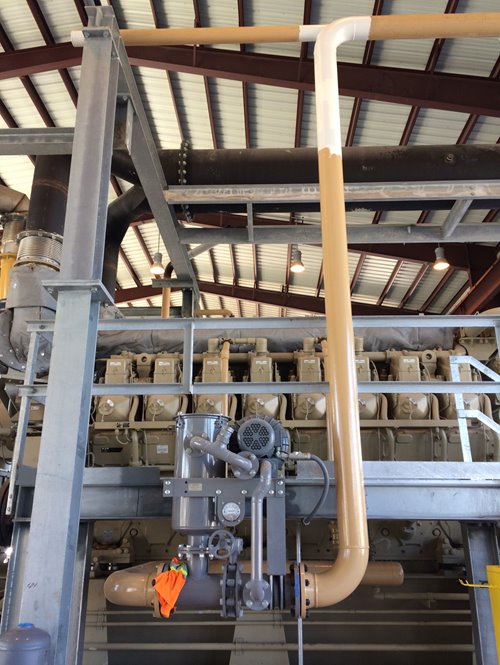
Vacuum assisted open crankcase ventilation system installed to eliminate oil mist emissions from a mechanical drive natural gas engine.
For these reasons, high efficiency crankcase ventilation systems are important for protecting the Operators, the environment and the engine itself. Both Solberg’s vacuum assisted (BAE and SME Series) as well as closed crankcase (ACV Series) are used to capture the vented oily crankcase emissions while maintaining the required crankcase vacuum or pressure.
Safety, uptime and minimizing maintenance are primary objectives for marine engine operators. Critical maritime applications include propulsion and electric power for military ships, tugs, tankers, dredgers, cruise ships and more. Given the confined nature of the crew and passengers, emissions control is critical. Since crankcase emissions primarily consist of oil mist, they become breathing and slipping hazards on ship decks. Once on the deck or ship structure, the oil will cause environmental damage by washing into the surrounding waterways.
A viable solution to meet the challenges of marine applications is an enhanced vacuum assisted open crankcase ventilation system , such as the Solberg BAE series. From an emissions standpoint, these systems include 99.97% efficient coalescing filters for 0.3 micron oil mist and particles. The coalescing filter element contributes to a clean breathing air environment on the ship and prevents oily mist contamination on the deck and into the surrounding waterways.
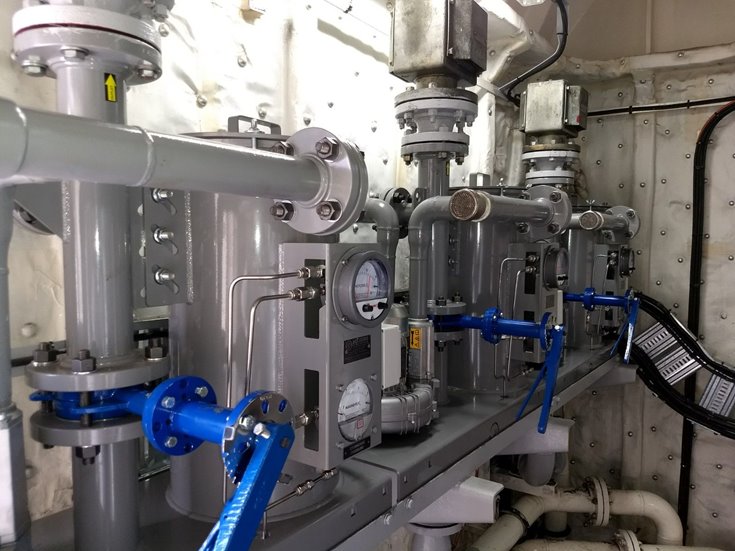
Vacuum assisted open crankcase ventilation systems retrofit onto diesel propulsion engines (marine research vessel) to capture hazardous oily emissions.
Marine engine brands including Caterpillar, Daihatsu, Hyundai, MaK, Man Diesel, Niigata and Wartsila are commonly used in the most rigorous applications. A feature of most marine diesel propulsion engines is that these ideally operate under atmospheric or slightly positive crankcase pressure. A recirculation style open crankcase ventilation system includes integrated piping to automatically maintain an engine’s natural crankcase pressure and eliminates the need for manual adjustments or expensive electronic controls. See examples this style with the Solberg BAE and SME series. The unique “re-circulation” piping configuration not only maintains the natural crankcase pressure, but also provides natural pressure relief in case the internal filter element becomes completely clogged or the vacuum source fails. These self-regulating features allows the ship’s crew to focus their attention on critical ship duties.
Retro-fit and new installations require a consideration of several factors to ensure ideal performance:
- Vent Piping: We recommend maintaining the vent pipe diameter to and from the crankcase ventilation system while avoiding low points and traps to prevent oil collection.
- Drain Lines/Tubing: During operation, oil coalesces and collects within the crankcase ventilation filter and must be continuously drained. We recommend that the connected drain line is submerged below the low oil level in the crankcase oil sump or used oil container. The destination for the oil depends on the recommendation of the engine manufacturer. Failure to properly drain will result in oil bypass around the filter and vented mist either into the atmosphere (open crankcase configuration) or into the engine intake system (closed crankcase configuration).
- Mounting Height: Since the crankcase ventilation system is typically under vacuum and a drain line is connected, the installation height is critical to ensure proper draining and to prevent oil bypass. Solberg’s Engineering team will recommend the ideal minimum mounting height during the technical discussions with our customers.
Whether an application for stationary power, mechanical drive or marine power, the challenges for Operators are similar: Emissions Control and Engine Performance. A crankcase ventilation system that is fit for purpose allows operators to meet these challenges. Solberg’s extensive field experience with customers and prospects has resulted in a vast knowledge base that we continually share with the marketplace. Our mission is to be the leading resource for the power generation market while offering high performance crankcase ventilation systems. Solberg’s system designs, technical knowledge, and field experience will result in the best solution for your application.
Contact Solberg and learn more about how our crankcase ventilation systems can provide solutions to the your unique application challenges.